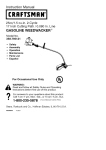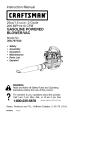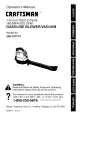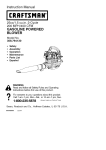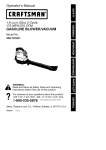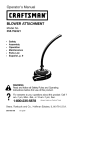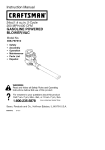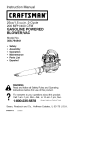Download Craftsman 358.794200 Operating instructions
Transcript
Operator's 0 O 0 Manual I CRAFTSMAN°I 20cc/1.2 cu.in. 2-Cycle 150 MPH/305 CFM GASOLINE Model BLOWER No. 358.794200 A 9 WARNING: Read and follow all Safety Rules and Operating Instructions before first use of this product. For answers Call 7 am-7 to your questions about this product: pm, Mon.-Sat., or 10 am-7 pm, Sun. 1-800-235-5878 Sears, Roebuck 530086310 3/14/01 and Co., Hoffman _Hoo,s listed are Central Time) Estates, IL 60179 U.S.A. Warranty Statement Safety Rules Assembly Operation Maintenance Service & Adjustments FULL ONE YEAR WARRANTY 2 2 4 5 7 8 Storage Troubleshooting Table Emissions Statement Parts List Spanish Parts Ordering ON CRAFTSMAN ® 9 10 10 12 15 Back Cover GAS BLOWER For one (1) year from the date of purchase, when this Craftsman Gas Blower is maintained, lubricated and tuned up according to the operating and maintenance instructions in the Operator's Manual, Sears will repair, free of charge, any defect in material or workmanship. This warranty excludes the blower tube, spark plug, and air cleaner, which are expendable parts and become worn during normal use. If this Blower is used for commercial purposes, this warranty applies for only 90 days from the date of purchase. If this Blower is used for rental purposes, this warranty applies for only 30 days from the date of purchase. This warranty applies only while this product is in use in the United States. WARRANTY SERVICE IS AVAILABLE BY RETURNING THE BLOWER TO THE NEAREST SEARS STORE OR SERVICE CENTER IN THE UNITED STATES. This warranty gives you specific which vary from state to state. legal rights, and you may also have other rights Sears, Roebuck and Co., D/817WA, 41_ WARNING: Failure to follow all Hoffman Safety Rules and Precautions can result in serious injury. KNOW YOUR UNIT • Read your Operator's Manual carefully until you completely understand and can follow all warnings and safety rules before operating the unit. • Restrict unit to users who understand and will follow all warnings and safety rules in this manual. _i_ WARNING: Inspect the area be- fore starting the unit. Remove all debris and hard objects such as rocks, glass, wire, etc. that can ricochet, be thrown, or otherwise cause injury or damage during operation. Use your unit as a blower for: • Sweeping debris or grass clippings from driveways, sidewalks, patios, etc. • Blowing grass clippings, straw, or leaves into piles, around joints, or between bricks. -2- Estates, IL 60179 PLAN AHEAD • Always wear eye protection when operating, servicing, or performing maintenance on unit. Wearing eye protection will help to prevent rocks or debris from being blown or ricocheting into eyes and face which can result in blindness and/or serious injury. Eye protection should be marked Z87. • Always wear foot protection. Do not go barefoot or wear sandals. • Always wear respirator or face mask when working with unit in dusty environments. • Secure hair above shoulder length. Secure or remove jewelry, loose clothing, or clothing with loosely hanging straps, ties, tassels, etc. They can be caught in moving parts. • Do not operate unit when you are tired, ill, upset, or if you are under the influence of alcohol, drugs, or medication. • Keep children, bystanders, and animals away from work area a minimum of 30 feet (10 meters) when starting or operating unit. Do not point blower nozzle in the direction of people or pets. HANDLE FUEL WITH CAUTION, IT IS HIGHLY FLAMMABLE • Eliminate all sources of sparks or flame (including smoking, open flames, or work that can cause sparks) in the areas where fuel is mixed, poured, or stored. • Mix and pour fuel in an outdoor area; store fuel in a cool, dry, well ventilated place; use an approved, marked container for all fuel purposes. • Do not smoke while handling fuel or while operating the unit. • Make sure the unit is properly assembled and in good operating condition. • Do not fill fuel tank while engine is running. • Avoid spilling fuel or oil. Wipe up fuel spills before starting engine. • Move at least 10 feet (3 meters) away from fuel and fueling site before starting engine. • Always store gasoline in a container approved for flammable liquids. OPERATE _WARNING: YOUR UNIT SAFELY Inspect unit before each use for worn, loose, missing, or damaged parts. Do not use until unit is in proper working order. • Keep outside surfaces free from oil and fuel. • Never start or run engine inside a closed room, building or other unventilated area. Breathing exhaust fumes can kill. • To avoid static electricity shock, do not wear rubber gloves or any other insulated gloves while operating unit. • Do not set unit on any surface except a clean, hard area while engine is running. Debris such as gravel, sand, dust, grass, etc. could be picked up by the air intake and thrown out through discharge opening, damaging unit, property, or causing serious injury to bystanders or operator. • Avoid dangerous environments. Do not use in unventilated areas or -3- where explosive vapors or carbon monoxide build up could be present. • Do not overreach or use from unstable surfaces such as ladders, trees, steep slopes, rooftops, etc. Keep firm footing and balance at all times. • Never place objects inside the blower tube; always direct the blowing debris away from people, animals, glass, and solid objects such as trees, automobiles, walls, etc. The force of air can cause rocks, dirt, or sticks to be thrown or to ricochet which can hurt people or animals, break glass, or cause other damage. • Never run unit without the proper equipment attached. When using your unit, always install blower tube. • Check air intake opening, and blower tube frequently, always with engine stopped and spark plug disconnected. Keep vents and discharge tube free from debris which can accumulate and restrict proper air flow. • Never place any object in the air intake opening as this could restrict proper air flow and cause damage to the unit. • Never use for spreading chemicals, fertilizers, or other substances which may contain toxic materials. • To avoid spreading fire, do not use near leaf or brush fires, fireplaces, barbecue pits, ashtrays, etc. • To reduce the risk of hearing loss associated with sound level(s), hearing protection is required. • Use only for jobs explained in this manual. MAINTAIN YOUR UNIT PROPERLY • Have all maintenance other than the recommended procedures described in the Operator's Manual performed by your Sears Service Center. • Disconnect spark plug before performing maintenance except for carburetor adjustments. • Use only recommended CraftsmanZ replacement parts; use of any other parts may void your warranty and cause damage to your unit. • Empty the fuel tank before storing the unit. Use up fuel left in carburetor by starting the engine and letting it run until it stops. • Do not use any accessory or attachment other than those recommended by the manufacturer unit. for use with your • Do not store the unit or fuel in a closed area where fuel vapors can reach sparks or an open flame from hot water heaters, electric motors or switches, furnaces, etc. • Store in a dry area out of reach of children. tinual and regular basis must monitor closely their physical condition and the condition of this tool. SPECIAL NOTICE: This unit is equipped with a temperature limiting muffler and spark arresting screen which meets the requirements of California Codes 4442 and 4443. All U.S. forest land and the states of California, Idaho, Maine, Minnesota, New Jersey, Oregon, and Washington require by law that many internal combustion engines be equipped with a spark arresting screen. If you operate in a locale where such regulations exist, you are legally responsible for maintaining the operating condition of these parts. Failure to do so is a violation of the law. For normal homeowner use, the muffler and spark arresting screen will not require any service. After 50 hours of use, we recomend that your muffler be serviced or replaced by your Sears Service Center. SPECIAL NOTICE: Exposure to vibrations through prolonged use of gasoline powered hand tools could cause blood vessel or nerve damage in the fingers, hands, and joints of people prone to circulation disorders or abnormal swelling. Prolonged use in cold weather has been linked to blood vessel damage in otherwise healthy people. If symptoms occur such as numbness, pain, loss of strength, change in skin color or texture, or loss of feeling in the fingers, hands, or joints, discontinue the use of this tool and seek medical attention. An anti vibration system does not guarantee the avoidance of these problems. Users who operate power tools on a con- CARTON CONTENTS Check carton contents against the following list. Model 358.794200 • Blower • Blower tube • Container of oil NOTE: It is normal for the fuel filter to BLOWER TUBE • Push the blower tube into the blower outlet until it snaps into place. Blower Outlet rattle in the empty fuel tank. ASSEMBLY _.WARNING: If received as- Blower Tube sembled, repeat all steps to ensure your unit is properly assembled and all fasteners are secure. Follow all safety information in the manuals and on the unit. • No tools are required for assembly. -4- '_ KNOW YOUR BLOWER READ THIS OPERATOR'S MANUAL AND SAFETY RULES BEFORE OPERATING YOUR UNIT. Compare the illustrations with your unit to familiarize yourself with locations of the various controls and adjustments. Save this manual for future reference. Pr mer Bu b Throttte Lever _ _._ ,',_'_'_%,_. Fue Cap ..... _,,,,j>, __ Che e Blower Tube \ Lever THROTTLE LEVER The throttle lever is used to select the desired engine speed and to stop the engine. To stop engine, move the throttle lever to the STOP position. starter rope. Activate the primer bulb by pressing it and allowing it to return to its original form. CHOKE LEVER The CHOKE helps to supply fuel to the engine to aid in cold starting, The CHOKE OFF position is used for full speed operation. The 1/2 position is used for a brief initial warm-up period and to set the engine at idle speed. PRIMER BULB The PRIMER BULB removes air from the carburetor and fuel lines and fills them with fuel, This allows you to start the engine with fewer pulls on the OPERATING TIPS • Operate power equipment only at reasonable hours-not early in the morning or late at night when people might be disturbed. Comply with times listed in local ordinances Usual recommen- • • • • • Use the full blower nozzle extension so the air stream can work close to the ground. • After using blowers and other equipment, CLEAN UP! Dispose of debris in trash receptacles. dations are 9:00 am to 5:00 pm., Monday though Saturday To reduce noise levels, operate power blowers at the lowest possible throttle speed to do the job To reduce noise levels, limit the number of pieces of equipment used at any one time. Use rakes and brooms to loosen debris before blowing. In dusty conditions, slightly dampen surfaces or use a mister attachment when water is available. BEFORE STARTING _WARNING: ENGINE Be sure to read tile fuel information in the safety rules before you begin If you do not understand the safety rules, do not attempt to fuel your unit. Call 1-800-235-5878. FUELING ENGINE _kWARNING: • Conserve water by using power blowers instead of hoses for many lawn and garden applications, including areas such as gutters, screens, patios, grills, porches, and gardens • Watch out for children, pets, open windows, or freshly washed cars. Blow debris away safely. -5- Remove fuel cap slowly when refueling. This engine is certified to operate on unleaded gasoline Before operation, gasoline must be mixed with a good quality synthetic 2-cycle air-cooled engine oil. We recommend Craftsman brand synthetic oil Mix gasoline and oil at a ratio of 40:1 (A 40:1 ratio is obtained by mixing 3.2 ounces of oil with 1 gallon of unleaded gasoline). NOT USE automotive oil or boat oil. DO These oils will cause engine damage. When mixing fuel, follow instructions printed on container. Once oil is added to gasoline, shake container momentarily to assure that the fuel is thoroughly mixed. Always read and follow the safety rules relating to fuel before fueling your unit. ;_¢_ -_X_, "_'_ STARTING POSITION IMPORTANT _bWARNING: Experience indicates that alcohol blended fuels (called gasohol or using ethanol or methanol) can attract moisture which leads to separation and formation of acids during storage. Acidic gas can damage the fuel system of an engine while in storage. To avoid engine problems, empty fuel system before storage for 30 days or longer. Drain gas tank, start engine and let it run until fuel lines and carburetor are empty. Use fresh fuel next season. Never use engine or carburetor cleaner products in the fuel tank or permanent damage may occur. See the STORAGE section for additional information. When starting en- gine, hold the unit as illustrated. Do not set unit on any surface except a clean, hard area when starting engine or while engine is running. Debris such as gravel, sand, dust, grass, etc. could be picked up by the air intake and thrown out through the discharge opening, damaging the unit or property, or causing serious injury to bystanders or the operator= STARTING A COLD ENGINE (or a warm engine after running out of fuel) 1. Move throttle lever to tile '1_ position. 2. Move choke lever to the FULL 3. CHOKE position. Slowly press the primer bulb 6 times. OPERATING POSITION Primer Bulb Eye Protection Lever STOPPING Choke Lever YOUR ENGINE 4. • To stop the engine, move the throttle lever to the STOP position. BEFORE STARTING THE ENGINE You MUST make sure the tube is secure before using the unit. • Fuel engine. Move at least 10 feet (3 meters) away from the fueling site. • Hold the unit in the starting position as shown. Make sure the blower end is directed away from people, animals, glass, and solid objects. -6- Pull starter rope sharply until engine attempts to run, but no more than 5 pulls. 5. Move choke lever to 1/2 CHOKE. Pull starter rope sharply until engine runs. NOTE: If engine has not started after 5 pulls, repeat all of the above steps. 6. After a 10 second warm-up, move the choke lever to CHOKE OFF. NOTE: Move throttle lever to the -_ position for low speed. 7. To stop engine, move the throttle lever to the STOP position. NOTE: If engine does not stop, move the choke lever to the FULL CHOKE NOTE: If engine does not run after 5 pulls, repeat STARTING A COLD ENGINE procedure. STARTING A FLOODED ENGINE Flooded engines can be started by placing the choke lever in the CHOKE OFF position and the throttle lever in the '_ position; then, pull the starter handle sharply to clear the engine of excess fuel. This could require pulling the starter handle many times depending on how badly the unit is flooded. If the unit still does not start, refer to TROUBLESHOOTING TABLE or call 1-800-235-5878. position. STARTING 1. 2. 3. A WARM ENGINE Move throttle lever to the _ tion. Move the choke lever to the posi- CHOKE OFF position. Pull starter handle sharply until engine runs. CUSTOMER RESPONSIBILITIES CARE & MAINTENANCE TASK Check for loose fasteners and parts WHEN TO PERFORM Before each use Check for damaged or worn parts Inspect and clean unit and decals Clean air filter Before each use Replace Yearly After each use Every 5 hours of operation spark plug GENERAL RECOMMEN DATIONS The warranty on this unit does not cover items that have been subjected to operator abuse or negligence. To receive full value from the warranty, the operator must maintain unit as instructed in this manual. Various adjustments will need to be made periodically to properly maintain your unit= CHECK FOR LOOSE FASTENERS AND PARTS • Spark Plug Boot • Air Filter • Housing Screws CHECK FOR DAMAGED OR WORN PARTS Contact your Sears Service Center for replacement of damaged or worn parts. • Throttle Lever - Ensure throttle lever functions properly by moving the throttle lever to the STOP position. Make sure engine stops; then restart engine and continue. • Fuel Tank - Discontinue use of unit if fuel tank shows signs of damage or leaks= INSPECT AND CLEAN UNIT AND DECALS • After each use, inspect complete unit for loose or damaged parts. Clean the unit using a damp cloth with a mild detergent= -7- • Wipe off unit with a clean dry cloth. CLEAN AIR FILTER Air Filter i / Screw ? Air Filter Cover Cleaning the air filter: A dirty air filter decreases engine performance and increases fuel consumption and harmful emissions. Always clean after every 5 hours of operation. 1. Clean the cover and the area around it to keep debris from falling into the carburetor chamber when the cover is removed. 2. Remove parts as illustrated. NOTE: Do not clean filter in gasoline or other flammable solvent. Doing so can create a fire hazard or produce harmful evaporative emissions. 3. Wash the filter in soap and water. 4. Allow filter to dry. 5. Apply a few drops of oil to the filter; squeeze filter to distribute oil. 6. Replace parts. REPLACE SPARK PLUG Replace spark plug each year to ensure the engine starts easier and runs better. Set spark plug gap at 0.025 inch. Ignition timing is fixed, nonadjustable. 1. Twist, then pull off spark plug boot. 2. Remove spark plug from cylinder and discard. 3. 4. the State of California _b WARNING: As your unit is used, carbon deposits build up on the muffler and spark arresting screen and must be removed to avoid creating a fire hazard or affecting engine performance. AND SPARK AR- _IWARNING: The muffler on this product contains chemicals Muffler is very hot during and after use. Do not touch the muffler or allow combustible material such as dry grass or fuel to do so. Replace with Champion RCJ-7Y spark plug and tighten with a 3/4 inch socket wrench (10-12 ft/Ibs). Reinstall the spark plug boot. INSPECT MUFFLER RESTING SCREEN to cause cancer. known to We recommend all service and adjustments not listed in this manual be performed by your Sears Service Center. CARBURETOR ADJUSTMENT Carburetor adjustment is critical and if done improperly can permanently damage the engine as well as the carburetor. If you require further assistance or are unsure about performing this procedure, call our customer assistance help line at 1-800-285-5878. Old fuel, a dirty air filter, a dirty fuel filter, or flooding may give the impression of an improperly adjusted carburetor. Check these conditions before adjusting the carburetor. The carburetor has been carefully set at the factory. Adjustments may be necessary if you notice any of the following conditions: • Engine will not idle. See LOW SPEED MIXTURE ADJUSTMENT (L) under adjusting procedure. • Engine dies or hesitates instead of accelerating. See ACCELERATION CHECK under adjusting procedure. • Loss of power. See MIXTURE ADJUSTMENT (L or H) under adjusting procedure. There are two adjustment screws on the carburetor. The low speed adjustment screw is marked with the letter L, and the high speed adjustment screw is marked with the letter H. The throttle lever is used to control engine speed. The throttle lever can be placed in one of four positions: STOP, IDLE or "J_, For normal homeowner use, the muffler and spark arresting screen will not require any service. After 50 hours of use, we recommend that your muffler be serviced or replaced by your Sears Service Center. FULLTHROTTLE or _, mittent position. High Speed Mixture Screw with Limiter Cap and one inter- Low Speed Mixture Screw with Umiter Cap ADJUSTING PROCEDURE CAUTION: Do not force plastic limiter caps on screws beyond the built-in stops or damage will occur. Initial Settings 1. Turn both mixture screws (L and H) counterclockwise until they stop. 2. Start engine, let it run for 3 minutes, then proceed to adjust screws according to the instructions below. If engine performance at initial settings is acceptable, no further adjustments are necessary. If engine does not start, refer to TROUBLESHOOTING TABLE. If still unable to remedy situation, call 1-800-235-5878. Low Speed Mixture Adjustment - L 1. Allow the engine to idle. 2. Turn low speed mixture screw (L) slowly clockwise until the speed begins to drop. -8- 3. Turn the low speed mixture screw (L) counterclockwise until the speed increases and then starts to drop again. 4. Set the low speed mixture screw (L) at the midpoint between the two positions. High Speed Mixture Adjustment - H CAUTION: Do not operate engine at full throttle for prolonged periods while making adjustments as damage to the engine can occur. Adjust the mixture screw 1/16 of a turn at a time. A 1/16 turn is about the width of the slot in the top of the screw. Allow the engine to idle. Turn the high speed mixture screw (H) counterclockwise until it stops. 3. Turn the high speed mixture screw (H) 1/16 of a turn clockwise at a time until the engine runs smoothly. After completing adjustments, check for acceleration. Reset if necessary. Acceleration Check If engine dies or hesitates instead of accelerating, turn the low speed mixture screw (L) counterclockwise until you have smooth acceleration. A fuel gum deposits during storage. Add stabilizer to the gasoline in the fuel tank or fuel storage container. Follow the mix instructions found on stabilizer container. Run engine at least 5 minutes after adding stabilizer. Craftsman 40:1,2-cycle engine oil (air cooled) is already blended with fuel stabilizer. If you do not use this Sears oil, you can add a fuel stabilizer to your fuel tank. WARNING: Perform the following steps after each use: • Allow engine to cool, and secure the unit before storing or transporting. • Store unit and fuel in a well ventilated area where fuel vapors cannot reach sparks or open flames from water heaters, electric motors or switches, furnaces, etc. • Store unit with all guards in place. Position unit so that any sharp object cannot accidentally cause injury. • Store unit and fuel well out of the reach of children. SEASONAL STORAGE Prepare unit for storage at end of season or if it will not be used for 30 days or more. If your unit is to be stored for a period of time: • Clean the entire unit before lengthy storage. • Store in a clean dry area. • Lightly oil external metal surfaces. FUEL SYSTEM Under FUELING ENGINE in the OPERATION section of this manual, see message labeled IMPORTANT regarding the use of gasohol in your engine. Fuel stabilizer is an acceptable alternative in minimizing the formation of 1. 2. ENGINE • Remove spark plug and pour 1 teaspoon of 40:1,2-cycle engine oil (air cooled) through the spark plug opening. Slowly pull the starter rope 8 to 10 times to distribute oil. • Replace spark plug with new one of recommended type and heat range= • Clean air filter. • Check entire unit for loose screws, nuts, and bolts. Replace any damaged, broken, or worn parts. • At the beginning of the next season, use only fresh fuel having the proper gasoline to oil ratio. OTHER • Do not store gasoline from one season to another. • Replace your gasoline can if it starts to rust. -9- TROUBLESHOOTING _, TABLE WARNING: Always stop unit and disconnect spark plug before performing any of the recommended remedies below other than remedies that require operation TROUBLE Engine will not start. of the unit. CAUSE REMEDY 1. Engine flooded. 2. Fuel tank empty. 3. Spark plug not firing. 1. See "Starting a Flooded Engine" in Operation section. 2. Fill tank with correct fuel mixture. 3. Install new spark plug. 4. Fuel not reaching carburetor. 4. Check for dirty fuel filter; replace. Check for kinked or split fuet line; repair or replace. 5. Compression 5. Contact low. your Sears Service Center. Engine will not idle properly. 1. Carburetor requires adjustment. 2. Crankshaft seals worn. 3. Compression low. 1. See "Carburetor Adjustment" in Service and Adjustments section. 2. Contact your Sears Service Center. 3. Contact your Sears Service Center. Engine will not accelerate, lacks power, or dies under a load. 1. Air filter dirty. 2. Spark plug fouled. 1. Clean or replace air filter. 2. Clean or replace spark plug and re-gap. 3. See "Carburetor Adjustment" in Service and Adjustments section. 4. Contact your Sears Service Center. Engine smokes excessively. 1. Choke partially on. 2. Fuel mixture incorrect. 1. Adjust choke. 2. Empty fuel tank and refill with correct fuel mixture. 3. Air filter dirty. 4. Carburetor requires adjustment. 3. Clean or replace air filter. 4. See "Carburetor Adjustment" in Service and Adjustments section. Engine runs hot. 3. Carburetor requires adjustment. 4. Carbon build up. 5. Compression low. 1. Fuel mixture 5. Contact incorrect. 2. Spark plug incorrect. 3. Carburetor requires adjustment. 4. Carbon build up. your Sears Service Center. 1. See "Fueling section. Engine" in Operation 2. Replace with correct spark plug. 3. See "Carburetor Adjustment" in Service and Adjustments section. 4. Contact your Sears Service Center YOUR WARRANTY RIGHTS AND OBLIGATIONS: The U.S. Environmental Protection Agency/California Air Resources Board and Sears, Roebuck and Co., U.S.A., are pleased to explain the emissions control system warranty on your year 2000-2003 small off-road engine. In California, all new small off-road engines must be designed, built, and equipped to meet the State's stringent anti-smog standards. Sears must warrant the emission control system on your small off-road engine for the periods of time listed below provided there has been no abuse, neglect, or improper maintenance of your small off-road en- -10- gine engine. Your emission control system includes parts such as the carburetor and the ignition system. Where a warrantable condition exists, Sears will repair your small off-road engine engine at no cost to you. Expenses covered under warranty include diagnosis, parts and labor. MANUFACTURER'S WARRANTY COVERAGE: If any emissions related part on your engine (as listed under Emissions Control Warranty Parts List) is defective or a defect in the materials or workmanship of the engine causes the failure of such an emission related part, the part will be repaired or replaced by Sears. OWNER'S WAR- RANTY RESPONSIBILITIES: As the small off-road engine engine owner, you are responsible for the performance of the required maintenance listed in your Owner's Manual. Sears recommends that you retain all receipts covering maintenance on your small off-road engine, but Sears cannot deny warranty solely for the lack of receipts or for your failure to ensure the performance of all scheduled maintenance. As the small off-road engine engine owner, you should be aware that Sears may deny you warranty coverage if your small offroad engine engine or a part of it has failed due to abuse, neglect, improper maintenance, unapproved modifications, or the use of parts not made or approved by the original equipment manufacturer. You are responsible for presenting your small off-road engine to a Sears authorized repair center as soon as a problem exists. Warranty repairs should be completed in a reasonable amount of time, not to exceed 30 days. If you have any questions regarding your warranty rights and responsibilities, you should contact your nearest authorized service center or call Sears at 1-800-469-4663. WARRANTY COMMENCEMENT DATE: The warranty period begins on the date the small off-road engine is purchased. LENGTH OF COVERAGE: This warranty shall be for a period of two years from the initial date of purchase. WHAT IS COVERED: REPAIR OR REPLACEMENT OF PARTS. Repair or replacement of any warranted part will be performed at no charge to the owner at an approved Sears Service Center. If you have any questions regarding your warranty rights and responsibilities, you should contact your nearest authorized service center or call Sears at 1-800-469-4663. WARRANTY PERIOD: Any warranted part which is not scheduled for replacement as required maintenance, or which is scheduled only for regular inspection to the effect of "repair or replace as necesThis engine is certified to be emissions [] Moderate [] Intermediate [] Extended sary" shall be warranted for 2 years. Any warranted part which is scheduled for replacement as required maintenance shall be warranted for the period of time up to the first scheduled replacement point for that part. DIAGNOSIS: The owner shall not be charged for diagnostic labor which leads to the determination that a warranted part is defective if the diagnostic work is performed at an approved Sears Service Center. CONSEQUENTIAL DAMAGES: Sears may be liable for damages to other engine components caused by the failure of a warranted part still under warranty. WHAT IS NOT COVERED: All failures caused by abuse, neglect, or improper maintenance are not covered. ADD-ON OR MODIFIED PARTS: The use of add-on or modified parts can be grounds for disallowing a warranty claim. Sears is not liable to cover failures of warranted parts caused by the use of add-on or modified parts. HOW TO FILE A CLAIM: If you have any questions regarding your warranty rights and responsibilities, you should contact your nearest authorized service center or call Sears at 1-800-469-4663. WHERE TO GET WARRANTY SERVICE: Warranty services or repairs shall be provided at all Sears Service Centers. Call 1-800-469-4663. MAINTENANCE, REPLACEMENT AND REPAIR OF EMISSION RELATED PARTS: Any Sears approved replacement part used in the performance of any warranty maintenance or repair on emission related parts will be provided without charge to the owner if the part is under warranty. EMISSION CONTROL WARRANTY PARTS LIST: Carburetor, Ignition System: Spark Plug (covered up to maintenance schedule), Ignition Module, Muffler including catalyst. MAINTENANCE STATEMENT: The owner is responsible for the performance of all required maintenance as defined in the owner's manual. compliant (50 hours) (125 hours) (300 hours) -11 - for the following use:












